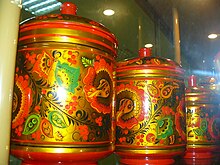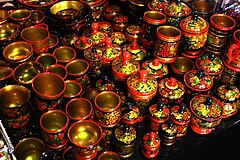114:
279:
255:
243:
267:
140:
76:, where it first appeared in the second half of the 17th century. This region is known for wood crafts ranging from small household goods to carvings on gables and gates in the traditional peasant cottages. The abundance of timber made for prolific and notable woodcarving traditions emerge throughout the centuries. Alongside Khokhloma, there are other wood painting styles and traditions as well as birch wood carvings throughout the Volga region.
20:
28:
136:, who, fleeing from persecutions of officials, took refuge in local woods. However, even earlier, local villagers had experience in making tableware from soft woods. Among the schismatics there were icon-painters, who taught local craftsmen the special technique of painting wood in a golden color without the use of genuine real gold.
158:
Due to the increasing number of factories and modern products, the late 19th and early 20th century saw a significant decline in folk art production and necessity at large. The two largest components that impacted
Khokhloma production significantly were the rising costs of timber and competition with
84:
Typical color schemes for
Khokhloma include a combination of red, black, and gold. However, the gold appearance is not typically real gold. The process involves coating the wood with drying oil, applying powdered aluminum (historically other metals have been utilized), and painted with heat resistant
104:
and breadboxes were significant pieces of household wares in
Russian hospitality. Many of these saltcellars were carved in the shape of a duck with a sliding lid on the duck’s back and wings. Breadboxes were typically carved in an oval shape which allowed for large surface areas to be painted on.
128:
called
Morozov to his bailiff, containing an order for the following: "One hundred painted dishes polished with powdered tin, both large and medium, of the very same kind possessed by us earlier, not forgetting twenty large painted wine bowls, twenty medium, and twenty somewhat smaller".
113:
92:
There are two principal wood painting techniques used in the
Khokhloma, such as the so-called "superficial technique" (red and black colors over the goldish one) and the "background technique" (a goldish silhouette-like design over the colored background).
230:
translation: "Golden
Khokhloma"), opened its doors to the public as a museum and tourist center. This museum features numerous examples of Khokhloma works for visitors to enjoy. There is also a 3D tour available on their website.
218:
Unique works of
Khokhloma art can be seen in a Khokhloma Museum that was opened in the factory of Semyonov in 1972. Among them there is a huge Khokhloma spoon 2 meters and 67 cm large and a bowl one and a half meter large.
105:
There have been instances of firebirds, fish, and other animals being the main subject matter. While the
Khokhloma style is used on these items, it is not the only painting style depicted on saltcellars or breadboxes.
89:. When the varnish is heated it gives a yellow/gold tint to the works emulating a gold-like appearance. The effect it has when applied to wooden tableware or furniture, making it look heavier and metallic.
175:
in the 1920s to early 1930s. During these decades more of the commonplace designs that we associate with the
Khokhloma were expanded upon and brought more creative endeavors in the design process.
57:) is a style of Russian art traditionally painted on wooden household items. It is known for its curved linear features depicting vivid small flowers, berries, grasses, and leaf motifs. The
155:
and
Khokhloma pieces were produced for Indian and Persian markets. Through an exhibition in Paris at the end of the 19th century, the Khokhloma style became known in the west.
458:
852:
278:
451:
379:
242:
857:
266:
837:
444:
847:
254:
61:, a common and popular figure from the Russian fairytales is often featured as the main subject matter.
727:
295:
58:
357:
750:
499:
69:
124:
The production of painted dishes in Khokhloma is first mentioned in 1659 in the letter of a
842:
559:
65:
8:
637:
514:
509:
194:. These two factories have become the Khokhloma centers of Russia and produce tableware,
692:
717:
541:
524:
484:
375:
529:
519:
227:
144:
47:
43:
775:
476:
191:
118:
816:
760:
722:
647:
632:
602:
494:
410:
801:
831:
770:
564:
536:
133:
811:
765:
667:
652:
607:
569:
195:
168:
73:
755:
732:
617:
139:
101:
64:
The style is named after the village of Khokhloma (56.973°N 43.902°E) in
672:
657:
642:
468:
326:. Translated by Svetlichny, Rosemary. Leningrad: Aurora Art Publishers.
436:
780:
702:
627:
612:
597:
551:
203:
117:
Khokhloma painting on a wooden ladle in the shape of a swan, made in
186:
near the Khokhloma village and an industrial association called the
19:
592:
584:
207:
806:
682:
677:
662:
574:
179:
162:
27:
707:
622:
152:
712:
489:
199:
172:
125:
16:
Russian wood painting handicraft style and national ornament
796:
86:
742:
85:
oil paints, and varnished. The works are then put in a
79:
151:In its early days, Khokhloma became known in the
829:
222:In 2008 a new museum and cultural center called
213:
167:The Khokhloma style was revitalized during the
31:Khokhloma tableware on a Soviet postage stamp.
452:
372:Das GoldeneChochloma - Dekorative Holzmalerei
163:Revitalization efforts under the Soviet Union
96:
353:
351:
374:. Germany: Interbook Business. p. 14.
369:
321:
459:
445:
411:"Туристические объекты "Золотой хохломы""
348:
171:era. The Khokhloma craftsmen united into
143:Ivan Bakanov. Khokhloma artists at work.
344:. Bloomington: Indiana University Press.
138:
112:
26:
18:
466:
399:. London: New York : "The Studio".
358:Khokhloma Ware: Folk art for the masses
830:
339:
132:The handicraft owes its origin to the
440:
394:
335:
333:
317:
315:
313:
311:
80:Design elements and creative process
13:
178:In the 1960s, the Soviets built a
46:: хохлома; Russian pronunciation:
14:
869:
853:Culture of Nizhny Novgorod Oblast
432:
330:
308:
277:
265:
253:
241:
403:
388:
363:
1:
370:Jemeljanowa, Tatjana (2001).
322:Yemelyanova, Tatyana (1980).
301:
214:Museums and cultural centers
7:
289:
248:Khokhloma during production
10:
874:
296:List of Russian inventions
234:
108:
97:Saltcellars and breadboxes
789:
741:
691:
583:
550:
475:
500:Kholmogory bone carving
395:Holme, Charles (1912).
340:Hilton, Alison (1995).
324:Khokhloma Folk Painting
148:
121:
70:Nizhny Novgorod Oblast
32:
24:
397:Peasant Art in Russia
272:Khokhloma giant spoon
142:
116:
53:(хохломская роспись,
30:
22:
858:Koverninsky District
560:Kasli iron sculpture
66:Koverninsky District
838:Russian handicrafts
638:Pavlovo Posad shawl
515:Fedoskino miniature
510:Russian lacquer art
848:Russian inventions
415:Музейные комплексы
188:Khokhloma Painting
149:
122:
55:hohlomskaya rospis
51:Khokhloma painting
33:
25:
825:
824:
751:Bird of Happiness
542:Zhostovo painting
525:Mstyora miniature
485:Gorodets painting
184:Khokhloma Painter
865:
530:Palekh miniature
520:Kholuy miniature
461:
454:
447:
438:
437:
426:
425:
423:
421:
407:
401:
400:
392:
386:
385:
367:
361:
355:
346:
345:
342:Russian Folk Art
337:
328:
327:
319:
281:
269:
257:
245:
145:Palekh miniature
873:
872:
868:
867:
866:
864:
863:
862:
828:
827:
826:
821:
785:
776:Matryoshka doll
737:
694:
687:
579:
546:
477:Decorative arts
471:
465:
435:
430:
429:
419:
417:
409:
408:
404:
393:
389:
382:
368:
364:
356:
349:
338:
331:
320:
309:
304:
292:
285:
282:
273:
270:
261:
260:Khokhloma wares
258:
249:
246:
237:
224:Золотая хохлома
216:
165:
119:Nizhny Novgorod
111:
99:
82:
17:
12:
11:
5:
871:
861:
860:
855:
850:
845:
840:
823:
822:
820:
819:
817:Vyazma pryanik
814:
809:
804:
799:
793:
791:
787:
786:
784:
783:
778:
773:
768:
763:
761:Filimonovo toy
758:
753:
747:
745:
739:
738:
736:
735:
730:
728:Musical spoons
725:
723:Russian guitar
720:
715:
710:
705:
699:
697:
689:
688:
686:
685:
680:
675:
670:
665:
660:
655:
650:
648:Podvorotnichok
645:
640:
635:
633:Orenburg shawl
630:
625:
620:
615:
610:
605:
600:
595:
589:
587:
581:
580:
578:
577:
572:
567:
562:
556:
554:
548:
547:
545:
544:
539:
534:
533:
532:
527:
522:
517:
507:
502:
497:
495:Filimonovo toy
492:
487:
481:
479:
473:
472:
464:
463:
456:
449:
441:
434:
433:External links
431:
428:
427:
402:
387:
380:
362:
360:by Stuart King
347:
329:
306:
305:
303:
300:
299:
298:
291:
288:
287:
286:
283:
276:
274:
271:
264:
262:
259:
252:
250:
247:
240:
236:
233:
215:
212:
164:
161:
110:
107:
98:
95:
81:
78:
15:
9:
6:
4:
3:
2:
870:
859:
856:
854:
851:
849:
846:
844:
841:
839:
836:
835:
833:
818:
815:
813:
810:
808:
805:
803:
800:
798:
795:
794:
792:
788:
782:
779:
777:
774:
772:
771:Kargopol toys
769:
767:
764:
762:
759:
757:
754:
752:
749:
748:
746:
744:
740:
734:
731:
729:
726:
724:
721:
719:
716:
714:
711:
709:
706:
704:
701:
700:
698:
696:
690:
684:
681:
679:
676:
674:
671:
669:
666:
664:
661:
659:
656:
654:
651:
649:
646:
644:
641:
639:
636:
634:
631:
629:
626:
624:
621:
619:
616:
614:
611:
609:
606:
604:
601:
599:
596:
594:
591:
590:
588:
586:
582:
576:
573:
571:
568:
566:
565:Faceted glass
563:
561:
558:
557:
555:
553:
549:
543:
540:
538:
537:Russian icons
535:
531:
528:
526:
523:
521:
518:
516:
513:
512:
511:
508:
506:
503:
501:
498:
496:
493:
491:
488:
486:
483:
482:
480:
478:
474:
470:
462:
457:
455:
450:
448:
443:
442:
439:
416:
412:
406:
398:
391:
383:
381:9785891640931
377:
373:
366:
359:
354:
352:
343:
336:
334:
325:
318:
316:
314:
312:
307:
297:
294:
293:
280:
275:
268:
263:
256:
251:
244:
239:
238:
232:
229:
225:
220:
211:
209:
205:
201:
197:
193:
190:in a town of
189:
185:
181:
176:
174:
170:
160:
156:
154:
146:
141:
137:
135:
134:Old Believers
130:
127:
120:
115:
106:
103:
94:
90:
88:
77:
75:
71:
67:
62:
60:
56:
52:
48:
45:
41:
37:
29:
23:Khokhloma set
21:
812:Tula pryanik
766:Dymkovo toys
653:Russian lace
608:Gymnastyorka
570:Podstakannik
504:
418:. Retrieved
414:
405:
396:
390:
371:
365:
341:
323:
223:
221:
217:
187:
183:
177:
166:
157:
150:
131:
123:
100:
91:
83:
74:Volga region
63:
54:
50:
39:
35:
34:
843:Handicrafts
802:Fabergé egg
756:Cheburashka
733:Treshchotka
695:instruments
618:Kosovorotka
469:handicrafts
182:called the
159:factories.
102:Saltcellars
832:Categories
673:Telnyashka
658:Sailor cap
643:Peaked cap
302:References
284:1957 stamp
781:Petrushka
703:Balalaika
613:Kokoshnik
598:Budenovka
552:Tableware
505:Khokhloma
208:souvenirs
204:furniture
36:Khokhloma
668:Stalinka
593:Afghanka
585:Clothing
467:Russian
290:See also
210:, etc.
198:(mostly
196:utensils
192:Semyonov
59:Firebird
807:Shashka
693:Musical
683:Valenki
678:Ushanka
663:Sarafan
575:Samovar
235:Gallery
228:English
226:(Rough
180:factory
147:, 1929.
109:History
44:Russian
40:Hohloma
708:Garmon
623:Kaftan
603:French
378:
200:spoons
173:artels
169:Soviet
153:Orient
38:(also
790:Other
718:Bayan
713:Gusli
628:Lapti
490:Gzhel
420:9 May
126:boyar
49:) or
797:Izba
743:Toys
422:2023
376:ISBN
87:kiln
202:),
834::
413:.
350:^
332:^
310:^
206:,
72:,
68:,
42:,
460:e
453:t
446:v
424:.
384:.
Text is available under the Creative Commons Attribution-ShareAlike License. Additional terms may apply.















